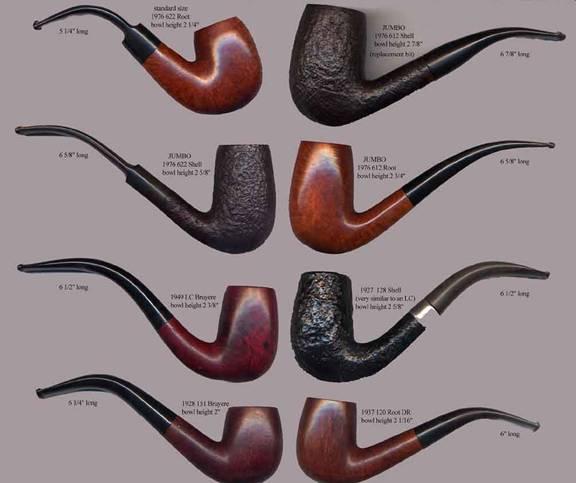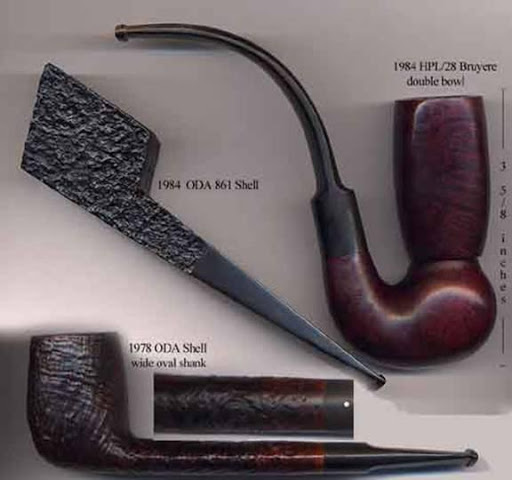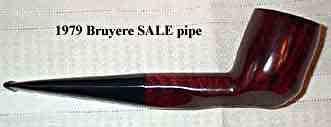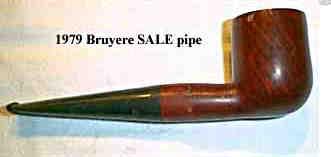La Dunhill Mini-Magnum du pauvre - La Jumbo 1976
La DUNHILL MINI-MAGNUM du pauvre – La JUMBO 612/622 de 1976, par John Loring et Richard Esserman (*) (12/01)
document fourni et traduit par Jean-Christophe Bienfait
Dunhill a toujours mis son point d'honneur à produire année après année des pipes de la meilleure qualité, selon un standard anglais classique et constant. Toutefois certaines années sont spéciales. Par exemple, pour des raisons évidentes très peu de pipes furent fabriquées en 1940, pourtant, d'après mon expérience, le plus étonnant c'est que si vous trouvez une Dunhill de 1940, vous avez de fortes chances que ce soit une Shell LB.
1976 marque une autre de ces dates particulières, car cette année là Dunhill fit des pipes courbes en quantité impressionnante, y compris une poignée de pipes qui pourraient peut-être bien être les plus grosses pipes jamais estampillées d'un numéro de forme standard Dunhill. (Oui, on en fabriqua de plus grosses, telles les formidables magnums des années 20 et 30 et peut-être quelques pièces de collection géantes (Collectors), mais aucune de ces pipes ne portait de numéro de forme standard). J'ai trouvé ma première de ces jumbos de 1976 à la fin des années 80 lorsqu'Iwan Ries, le magasin de pipes de Chicago, commença de liquider la collection personnelle d'un vendeur de Dunhill retraité le même jour où, par coïncidence, je parcourais le magasin. C'était une Shell ¾ courbe à tuyau sifflet (saddle bit) numéro de forme 622, avec un fourneau haut de 6,7 cm (2 5/8 "). A presque tous égards, le tuyau saddle en moins, la jumelle d'une jumbo LC de la fin des années 20 quand cette forme était fabriquée plus haute de 0,6 cm qu'avant cette période ou qu'elle le fut après. L'argent n'est jamais sorti aussi vite de ma poche que ce jour là.
Une décennie plus tard, cependant, c'est dorénavant le bébé de ma collection car au cours des années passées j'ai pu faire l'acquisition de deux de ces impressionnantes jumbos ¾ courbe de 1976 de plus. L'une est la compagne avec tuyau fuselé (tapered) de mon acquisition précédente, une 612 (le 1 au lieu du 2 indique le tuyau fuselé) avec l'avantage considérable de n'être pas seulement une finition Root mais également d'être plus grande d'un huitième de pouce (0,32 cm). Un huitième qui en fait d'après mes dernières informations la plus grande des LC jamais fabriquées. L'autre est une Shell 612 de 2 " 7/8 (7,3 cm) de haut également remarquable, d'une profondeur appréciable, au fourneau plus généreux. Une forme classique 151, mais deux fois plus large, qui rend mes deux autres jumbos 612/622 rachitiques en comparaison.
While only a handful of these jumbo 1976 ¾ 612/622 bents were made (and not to be confused with the many large but standard group 6 sized 612 and 622 bents made in 1976) after gazing at them in awe, the intriguing question that comes to mind is why in 1976 and only in 1976.
The answer I think is a bit of British ‘Spring Cleaning’ occasioned by the change over from the traditional individual shape numbering system to the modern day shape category system, the acquisition of Lane Limited (Charatan brand pipes), a US marketing initiative and an MBA realization that unfinished briar is wasted money.
Based upon reasoned speculation and discussion with certain Dunhill management, over the years since World War Two, or perhaps even before, Dunhill had set aside the occasional large briar pieces for future use. That is until it had a custom order or alternatively a sufficient accumulation to make a run of rare extra large shapes such as the LC. The shift in 1975 however, to the modern day shape category system meant that a number of distinctly different shapes could be inventoried and distributed under the same shape number, as the 612s and 622s pictured here demonstrate. At the same time the acquisition of Lane Limited forced a review of the two company’s pipe making facilities and most likely brought to the attention of the MBA types that a significant amount of valuable briar was accumulating dust. I suspect this prompted a command from on high to turn the wood into sterling, leading in turn to the concentrated carving in 1976 of previously set aside briar suitable for large bent shapes, including a few particularly large briars from which my three pipes came.
But if this large and jumbo bent production was unique to 1976, the impetus behind that production was, I think, not and indeed represents the initial, glorious peak of what can only be termed a five year roller coaster ride. For instance in 1978, and unique to 1978 we see a number of ODA 845 Canadian variants with distinctly wide oval shanks of various lengths. Unfortunately, there were no pipes to my information in the Canadian shape akin to the few jumbo 612/622s of two years pervious, but still they were wide oval shank pieces so distinct that at a glance across a room you recognize the year that they were carved.
But Dunhill’s stockpile of accumulated briar was far too substantial to be seriously dented by an extra generous production of bent shapes in 1976 and Canadian shapes in 1978 and there were other considerations as well. First, the 1975 announced end of ODA production had not been well received in America. So given both American market and MBA/corporate demands a 1978 reintroduction of the entire large classic shape “Giant”/”ODA” line was a natural. (Of course consistent with the end of its individual pipe shape numbering system, these ODAs were initially reintroduced without the traditional “800” pipe shape number stampings.)
Second, Dunhill was hardly oblivious to the favorable impression Danish freehand pipes had made in America during the 1960s. Indeed in the early 1970’s it had experimented at its Harcourt factory with plateau topped freehand bowls using preturned but hand finished stems. (These were marketed as Dunhills with an “S/G” stamp.) Nor of course was it unfamiliar with the popularity of its newly acquired Charatanline of Danish influenced English style free hands, i.e. the Distinction, Executive, Selected and Supreme. So again in retrospect it was almost natural for Dunhill to begin Dunhill factory production in 1978 of the Collector line of free hand style pipes.
Unfortunately, MBAs seem always to be young and impatient, the cigarette smoking type with little patience for either a pipe or unused inventory. And beginning late in 1978 I suspect that was the genesis to the most embarrassing disaster in a century of Dunhill pipe making. I refer of course to the circled group size 6 (and rare circled group size 5) Bruyeres primarily associated with 1979 but found on occasion with 1978 and 1980 date stamps.
Not all large briars are either well grained enough to be destined to be a Collector line pipe, or otherwise of a shape easily carved into a well balanced premium grade pipe and as Dunhill attacked its accumulated stockpile of briar, a second stockpile of these ‘less then satisfactory’ but not imperfect briars must of begun to grow. Corporate folks however, hunched over spread sheets, with a cigarette smoldering near by tend to see only unused inventory, and beginning in late 1978 and continuing into early 1980 one sees a series of abortions usually with a circled group size 6, never with a shape number, and invariably in the Bruyere finish, with clumsy bowl shapes and normally coupled with poorly fitted bits (if not poorly fitted it is probably a replacement). If one did not know for a fact that in 1978 Dunhill distributed these pipes at a radically reduced $50 ‘sale’ price (some, but not most, ‘sale’ pipes had XX’s stamped on the shank), one would not hesitate to label them ‘counterfeits’ on the quality, or rather lack of quality, of manufacture alone. Or to put it very kindly a hastily made group of pipes.
In life however, we are ultimately measured not so much by the mistakes we make but how we react to them and if I may complete my speculation, it seems to me that early 1980s Dunhill production indicates that indeed Dunhill recognized and reacted to its 1979 circled group 6 Bruyere disaster. For in the early 1980s together with continued production of the Collector and reintroduced ODA lines we see a number of unusual Dunhill pipes replicating some of its most unusual older limited production shapes, suggesting to me a continuation of turning an accumulated inventory of briar into sterling but unlike, 1979, and consistent with 1976 and 1978 doing so within a tradition of classic English style shapes of the finest quality.
All and all then for an old fashion, stogy English company, the second half of the 1970s is a remarkable period with an incredible low, peaks of considerable interest and for me, the incredible high point of Dunhill’s 1976 production of a handful of 612 and 622 ¾ bent shapes with bowl heights exceeding 2 ½” up to 3”, the largest standard shape numbered pipes Dunhill has ever produced.
(*)(This paper could not have been written save for Richard Esserman. While most of us began as ‘smokers’ and slowly developed into collectors, Richard merged the two interests almost immediately and coupled them with a phenomenal memory and a discerning eye. He is in all a remarkable and generous resource.)
Back to Loring's articles here



